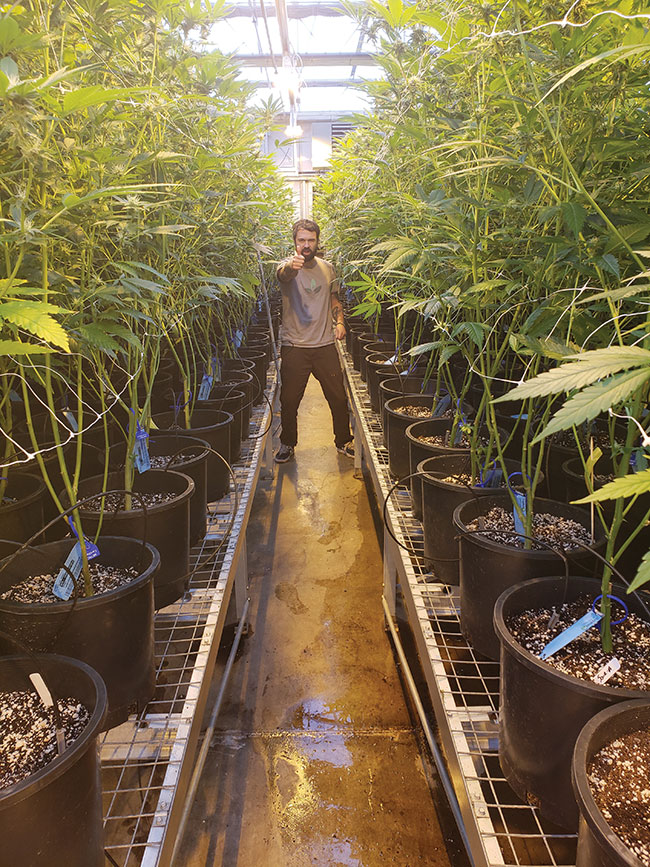
Features
Business
Cultivation
Human Resources
Management
Marketing
Production
Pot of wisdom
What Canada can learn from Oregon’s cannabis rollercoaster
December 11, 2019 By Max White
 Max White (in photo), director of cultivation at Aroma Cannabis in Canby, Ore.
Max White (in photo), director of cultivation at Aroma Cannabis in Canby, Ore. Oregon and Canada have long shared historical roots in our beloved cannabis industry. Generations of farmers have poured their passion, sweat equity, and even risked their freedom to further the development of this plant. The Pacific Northwest spans from California to Canada, and is largely responsible for setting the pace for a booming, newly emerging world market.
Recognition that cannabis is woven into the state’s cultural fabric initially emerged as institutional tolerance when Oregon became the first state in the U.S. to decriminalize marijuana possession in 1973. In January 2014, Measure 91 was passed legalizing recreational use for adults over the age of 21. In late 2016, producer licensees were finally being issued and the growth began. Oregon had no restrictions on applying for a producer license. A non-refundable $250 put an application in queue. Low license cost (maximum of $6,000) and the fact that anyone from anywhere in the world could apply, quickly set the pace for an exhaustive, competitive market.
To put it into perspective, at the time of this article, Canada has a little over 200 licence holders, a population of about 38 million people, and the ability to export product outside the country. Oregon has 1,200 active producer licences with 800 more in the queue slowly coming on line. Oregon has a state population of four million, and cannot distribute outside of the state. Oregon growers have out-produced what the state could consume and, in the Spring of 2019, the state reportedly had a three-year surplus of material. Prices plummeted from an average of $2,000/lb to $750/lb. Sixty per cent of the producers went out of business. Retailers were offering $50-ounces on every block trying to win over consumers. As cannabis is a new industry and each grower is different than the other, cost of goods sold and margins vastly differ. The state was forcing producers to get good at their job, or get out. Coming into 2020, the market has matured and lessons have been learned.
Our company should have gone out of business several times but we found our bottom and survived.
My name is OneEye Max. I have been cultivating cannabis legally in both the state medical and recreational markets for the last 20 years. There is a ton we can both learn from each other during this time in two different markets. I am humbled by the opportunity to share my perspective as well as offer my two-cents on what Canada can learn from my experience navigating Oregon’s rollercoaster “cannabliss” industry. Below I will talk about several topics and then offer a few key points on how we managed to get through each unique tribulation with a better strategic foresight.
Efficiency
When we grew on the ‘free market’ there was never the issue of dissecting our cost. The margins were wonderful and the demand was high. At the end of the day, I knew I was bringing in more than I was spending.
Fast forward to a super saturated market where outdoor pounds are being auctioned off at $50 per pound, and sales are through the floor. Instead of running to investors and asking for money, the only way we saw possible to survive was to dissect the budget, look closely at job functions, streamline duties, and focus on garden timelines in order to give us the stay power in navigating the market.
My company, Aroma, went through 30 employees during the first year of operation. The honeymoon phase ends and the glory of working a pot farm fades. We have become 40 per cent more efficient as a company since Year One, mostly through job function data and incentive programs with employees. We get more done with 12 employees than we did with 30 – and in a more timely fashion.
Key points:
When hiring employees, be thorough. Do your research and be as descriptive as possible when explaining the job duties. When hiring for garden labour, I prefer an agriculture or general commercial cultivation background to any “master grower” experience.
Use a probation period. We do monthly evaluations to help steer the employee in the right direction and ask questions of them to better refine our own management programs. If in 90 days we aren’t getting what we need out of the employee, then it’s best to part ways and hire somebody who will grow with us.
Entertain employee incentive programs. It is cheaper for us to reward benchmarks from employees than to hire additional help to complete the task. The employee hits goals and gets rewarded, and payroll still remains cheaper, as well as the overall management overhead.
Keep data for everything, especially job functions. How long does it take to trim this certain strain of product? What are the best strains in the garden from a grower’s perspective? And what are the best strains from a post-harvest perspective? And why?
Develop a business flow that operates inside predetermined timelines.
Relationships
As with any industry, relationships can make or break your business. We’ve all heard the phrase, “It’s not what you know, it’s who you know.” Your network is your net worth. And that couldn’t be more true for the cannabis industry.
In Oregon, before recreational was legalized, this industry was built on relationships. If you didn’t know someone directly in the game, you weren’t a part of it.
When I first entered the cannabis industry in the late 1990s, the only way to navigate the market then was through relationships and building a network of like-minded individuals. It was in these privileged and, in my opinion, sacred circles of people in which I personally learned my growing techniques and established distribution chains for product – where I acquired the ins and outs of the cannabis hustle.
Now, fast forward 20 years. What an entertaining stew of individuals we have rushing to get a hot seat in the cannabis game. Knowing your partners is key, so is being able to talk plainly. Be vulnerable and have excellent communication with your people. The only way I have been successful is by continuously building on my network support system. If I have, say, a bug problem, I have the whole picture of people to help me through the process. From bug identification, to process of treatment, to product sourcing to follow up protocols. I can now waste little time eradicating a problem, while spending only the necessary money. It is a game changer having good relationships inside an ever-growing network.
Key points:
There is no shortage of information on every topic inside the cannabis industry. Much of it is unproven or biased. Do your research, and as you find people that continuously offers good information, hold on to them. Help them if you can as well.
Develop relationships with your supply chain vendors. For instance, the fertilizer company will have insights and new tips and tricks that you can benefit from – or trial programs that can be nice.
Develop relations with other licensed growers. This is huge for us. We are all playing the same game by the same rules in Oregon, and sharing amongst each other has yielded amazing results. We even create buying power for products, share labour, and strategize product value in the market with each other.
Be good to your budtenders. Get samples in their hands. Let them smoke your product. Because when there are 200 different jars of flower on the shelf, you want them to remember you and your farm’s story.
Best practices
Everybody has a different business strategy. Just because you grow organic, no till soil, hand-trimmed, magic, pure, flower from a farm of plant lovers… doesn’t mean you are unique. Sure those are great attributes, but my outlook has changed for my lane in this industry. I have learned to let go of certain things in our production facility process in order to stay competitive in the market. We produce consistent, large batches of cannabis flower monthly. We operate on a monthly timeline. And we know what are target price points should be. Whereas before when I was a smaller size grower I would only hand trim product, it only makes sense for our facility to incorporate some machine trimmers. We are running a business after all and where quality will always be number one for me, I have to pay attention to quantity as well. Does it pencil to operate the way we are doing this, or is there a better way? Best practices and efficiency are similar subjects but with best practices you can insure consistency in your product and streamline labour tasks to operate smoothly and effectively.
Key points:
Once again, data is our friend. We are constantly trialing new ideas and methods at a small scale to see if it can be inputed into our processes.
Keep in touch with new technology. We have companies show us new technology every month: maybe it’s a new light, or new media, or a nutrient additive; maybe a camera system that alerts with drought or bug pressure. Automation and new tech pay for themselves very quickly, in our experience.
Know your market. If you are specializing in medical strains, learn it, know your competitors. Stay in your lane. Identify what you are good at and own it.
Growing environment
There are three main environments in the commercial growing world: outdoor, indoor and, more recently, commercial greenhouses. They each have their own pros and cons, in my opinion.
Indoor facilities have the ultimate environmental control and bug outbreak insurances with plant separation in multiple rooms. The downside being the cost to start up, operate, and the effect on price/gram to produce.
Outdoor is generally the cheapest method. And you can utilize the sun for big fat buds. But on the other side of the coin, the product is subject to poor natural elements as well. Mold and bugs can get out of hand quickly. This product fetches a lower market value as it generally lacks the visual attraction that a nicely pampered indoor flower can achieve.
But as Aroma developed its business strategy, we decided to utilize the sun and build a 12,000-square-foot commercial greenhouse. We have multiple zones in the garden that use automated black out curtains to separate plant growth stages and photoperiods. The decision in using the greenhouse revolved around the benefits of the sun. Our operation costs, and even start-up costs, are less than an indoor facility, while still being able to achieve similar quality to indoor flower. We love our growing facility, but at the end of the day it is a personal preference on the facility type you choose.
Key points:
Develop a preventive integrated pest management program and keep on it like stank on chronic. One of the biggest challenges cultivating inside a greenhouse has, and will continue to be, is controlling pests.
Prepare and understand your region’s outside weather habits. I now have pre-set environmental control set points on thumb drives for spring, winter, summer, etc.
If it is a rainy condition, plan for extra dehumidification and good drainage. You will want to carefully plan and manage watering methods, too.
Be aware of what your neighbours do on their land. We are located next to a hazelnut tree farm, which sprays by helicopter once a year. We have failed pesticide tests when our trim is processed into oil. Cannabinoids as well as pesticides concentrate so even the smallest amount (Oregon tests some pesticide analytes down to the ppb) can turn into a fail.
Be aware of neighbouring hemp farms. Yep, we have also seeded from hemp farmers not properly culling their fields of male plants.
Sharing a common space for all the plants has proven tough for controlling pests, keep this in mind when building or retrofitting an existing greenhouse.
Measure the incoming sunlight so you know how much supplemental light to supply in order to hit target daily light interval levels for explosive growth.
Foresight for the future
In Oregon we had a massive influx of entrepreneurs. Rightfully so. Cannabis is fun, mysterious and mythically profitable. The first year for us was new, hard and full of lessons. The second year was a nightmare – an all-out growers’ hell. Now those of us that are left are licking our wounds optimistically with a hope of market redemption.
Oregon will be the first state to allow national distribution and the country will be making big decisions to further cannabis rescheduling and overall national market trade.
Oregon has been a tough lesson for us, but an absolute crash course in business, networking and cultivation. I hope some of the tidbits I shared above can help anyone reading this. Keep your head emerged in your craft. Ask lots of questions. Be kind. And enjoy the ride. (This article was written with help from Erik VonEggers, general manager at Aroma Cannabis.)
Follow us @AromaCannabis and @Oneeye_max
Max White is the co-owner and director of cultivation at Aroma Cannabis in Canby, Oregon.
Print this page

